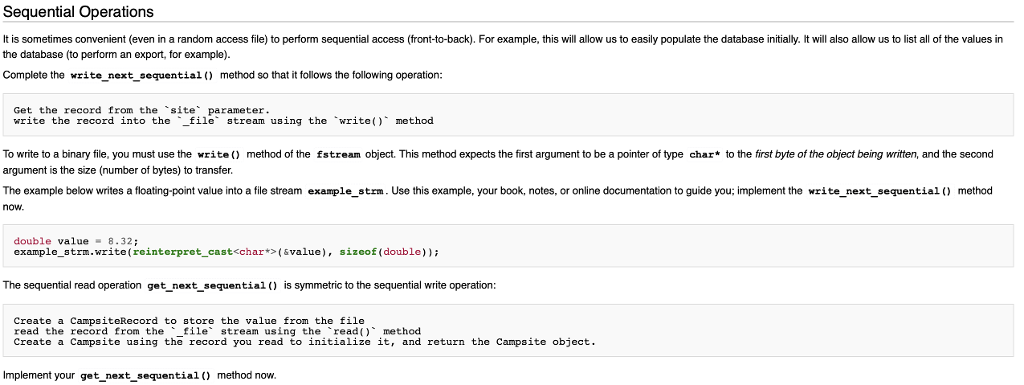need c++ format here is start code class CampsiteDB { public: CampsiteDB( std::string filename ); int get_record_count( ); int get_current_index( bool write=false ); Campsite get_next_sequential( ); Campsite get_at_index( int index ); void write_next_sequential( const Campsite& site ); void write_at_index( int index, const Campsite& site ); void print_record( int index, std::ostream& strm = std::cout ); void list_records( std::ostream& strm = std::cout ); // This object is non-copyable CampsiteDB(const CampsiteDB&) = delete; CampsiteDB& operator=(const CampsiteDB&) = delete; private: // private methods: void _create_file( ); bool _open_file( ); // attributes std::string _filename; std::fstream _file; }; 

Implement the constructor for the campsite storage database. The constructor will always open the file (if possible). If the file doesn't exist, it must be created. We will detect this by trying to open it the way we want first, then detecting a failure, trying to create, then trying again to open. If all of that fails (we can't create the file), we have no choice but to throw an exception. The algorithm follows; make use of the _open file and create file helper methods when you implement. try to open the file - if we fail to open the file: try to create the file try to open the file -- if we still fail, throw a std:iruntime_error exception saying "Unable to create the database. Now we must immediately implement the two private helper methods _open file and _create file. The operate on the_file attribute as follows: _open_file) should open the file whose name is _filename with input, output, and binary mode flags. Then, use the stream seekp) method to seek the "putt position to the end of the file (seek to 0 bytes from std: :ios: :end). This will allow immediate appending of new values at the end, if desired. The result of testing whether the file is indeed open after this operation should be returned ( true if the file is open false otherwise). create file) should open the file whose name is_filename in output mode (this will create the file, if you have permission). The file stream should then be immediately closed. Create method stubs for all of the other methods in CampsiteDB so that you can compile. Add the following to your main program and check that it compiles. CampsiteDB db( campsites.db" Run the program and verify that the file "campsites.db" is being created. It is currently empty (size zero); you may delete it and re-test as needed Implement the constructor for the campsite storage database. The constructor will always open the file (if possible). If the file doesn't exist, it must be created. We will detect this by trying to open it the way we want first, then detecting a failure, trying to create, then trying again to open. If all of that fails (we can't create the file), we have no choice but to throw an exception. The algorithm follows; make use of the _open file and create file helper methods when you implement. try to open the file - if we fail to open the file: try to create the file try to open the file -- if we still fail, throw a std:iruntime_error exception saying "Unable to create the database. Now we must immediately implement the two private helper methods _open file and _create file. The operate on the_file attribute as follows: _open_file) should open the file whose name is _filename with input, output, and binary mode flags. Then, use the stream seekp) method to seek the "putt position to the end of the file (seek to 0 bytes from std: :ios: :end). This will allow immediate appending of new values at the end, if desired. The result of testing whether the file is indeed open after this operation should be returned ( true if the file is open false otherwise). create file) should open the file whose name is_filename in output mode (this will create the file, if you have permission). The file stream should then be immediately closed. Create method stubs for all of the other methods in CampsiteDB so that you can compile. Add the following to your main program and check that it compiles. CampsiteDB db( campsites.db" Run the program and verify that the file "campsites.db" is being created. It is currently empty (size zero); you may delete it and re-test as needed








